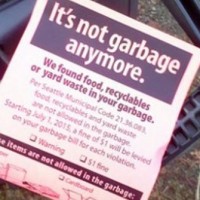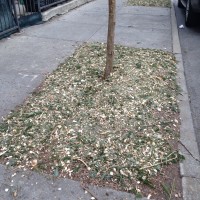Tags: recycling
Leading the Charge for a Sustainable Tomorrow

Batteries work on positive and negatives, much like our daily lives work on batteries. Today is National Battery Day, and while the origins are not definitively known, February 18th commemorates the birth of Alessandro Volta, the “father” of the battery.
...MOREWhat is in NYC’s Trash?

Picture this: You’re finishing up a carton of milk. You pour out the last drop and rinse it out. Then, you walk over to your home recycling station to decide where the carton should go. Trash? Paper and cardboard? Glass, metal, and plastic?
...MOREWaste Diversion in New York City

As Freshkills Park develops from the world’s largest landfill into a sustainable urban park, New York City is working towards sending zero waste to landfills by the year 2030. This 0x30 Initiative is under the April 2015 initiative known as One New York: The Plan for a Strong and Just City (OneNYC).
...MORE“Seven Work Ballets” by Mierle Laderman Ukeles

The work of Mierle Laderman Ukeles, the artist-in-residence for the NYC Department of Sanitation for the past 30+ years, is featured in a new book edited by Kari Conte titled “Seven Work Ballets.” According to Sternberg Press, the book focuses on a series of seven grand-scale collaborative performances that took place between 1983 and 2012 in New York, Pittsburgh, Givors, Rotterdam, and Tokamachi.
...MOREStudents Take a Stand against Plastic Bags after Visiting Freshkills Park

On February 9th, students at James Madison High School built a chain of plastic bags around the school building in Sheepshead Bay, Brooklyn. The project was meant to raise awareness about excessive use of the material and its harmful impact on the environment.
...MOREClose to Foam

At around 95% air, Expanded Polystyrene foam (EPS) is incredibly buoyant, which is why it was used by the U.S. Coast Guard to build a six-person life raft in 1942.
EPS, commonly known as Styrofoam, has since floated into everyday life, with people using billions of foam cups, bowls, plates, takeout containers, trays, and packing peanuts every year.
...MOREFarther Afield: Gazing Globes at Madison Square Park

If you haven’t yet visited Paula Hayes’ Gazing Globes at Madison Square Park, I highly recommend a trip to 25th street around dusk before the exhibition closes on April 19th. Hayes’ first public art exhibition in NYC comes alive as the sun starts to set over the city.
...MOREFarther Afield: Seattle Bans Food Waste

Seattle Public Utilities (SPU) has recently added a $1 fine for having more than 10% of a household’s trash composed of food waste. Passed on January 1, 2015, this comes as the next step in Seattle’s attempt to remove compostable materials from ending up in landfills, following the city’s previous 2005 ban on recyclable materials under a similar $1 fine program and the encouragement of residents to compost via SPU-provided compost bins.
...MORERecycling Christmas Trees for Myriad Uses

Every January, many cities are stuck dealing with an influx of Christmas trees after they’ve been removed from cozy homes and cast into the city’s waste management system. While Christmas trees may often be left out for landfill dumping, some municipalities and environmentalists have come up with ways to recycle them, keeping trees out of the waste stream.
...MOREEthics of E-waste

A few weeks ago, my iPhone 4s slowly started to malfunction. When the battery started to die within hours of being unplugged, I thought, ‘easy fix… it needs a new battery.’ Then one day I tried to make a call but no one could hear me.
...MOREFarther Afield: Singapore’s Farms, Towers and Open Water

With a population of nearly 5.4 million people on less than 300 square miles of land, Singapore is the third densest country in the world. Once a part of Malaysia, it became an independent nation in 1965, and by doing so, the new island city-state began to increasingly rely on importing food to feed its people.
...MOREFarther Afield: Garbage, Big Business in the Big Apple

Garbage is big business in the Big Apple—nearly 2 billion dollars worth of the city’s budget goes to the Department of Sanitation (DOS); and of that: $300 million is spent just disposing of it elsewhere. Last year this amounted to a cost of $95 per ton, up 28% since 2004, far outpacing inflation.
...MOREFarther Afield: Food Unwrapped

From boxed rice to a can of soup, our food comes in packaging that is designed to be disposed of; even produce at some stores is offered in pre-packaged, cling-filmed trays. While it is encouraged that we recycle as much of these disposable packaging materials as possible (including the plastic wrap!),
...MORESF Bans Bottled Water on City Property

The City of San Francisco recently announced that it would ban the sale of bottled water in containers less than 21 oz on city property. San Francisco will be the first major city in the US to enact such a ban, though Concord, Massachusetts and Grand Canyon National Park have already replaced bottled water with water bottle filling stations.
...MORECitywide Commercial Organic Diversion

In a bold piece of legislation, New York City will reduce its waste by one third by requiring that, by 2015, restaurants, grocery stores, and other commercial food generators send all of their organic waste, including food scraps, to either a compost facility or an anaerobic digester.
...MOREStyrofoam Ban Marks New Path in Sustainable Waste Management

A bill was recently passed to ban Polystyrene Foam (also known as Styrofoam) in New York City’s food service, joining cities like Portland, Oregon; San Francisco; Seattle; and Amherst, Massachusetts. Most recycling programs, including New York City’s, do not accept Foam Plastics for recycling because the material necessitates separate processing and must be kept exceptionally clean.
...MOREFood Waste Challenge Saves Leftovers from Landfill

It might be easy to imagine designating a bottle or a newspaper for recycling or reuse – but food? That is the purview of former Mayor Bloomberg’s Food Waste Challenge. Over 100 New York City restaurants have made a commitment to divert at least 50% of their food waste.
...MORENew Recycling Facility Demonstrates Sustainability

The Art of Recycling

The Freshkills team is always on the lookout for engaging initiatives that combine education, sustainability, and art – not to mention recycling. Recology, a waste management company based in San Francisco, supports a young artists program that combines all these topics in one exemplary project.
...MORE




